初中英语情态动词讲解 练习及答案
- 格式:doc
- 大小:104.00 KB
- 文档页数:8
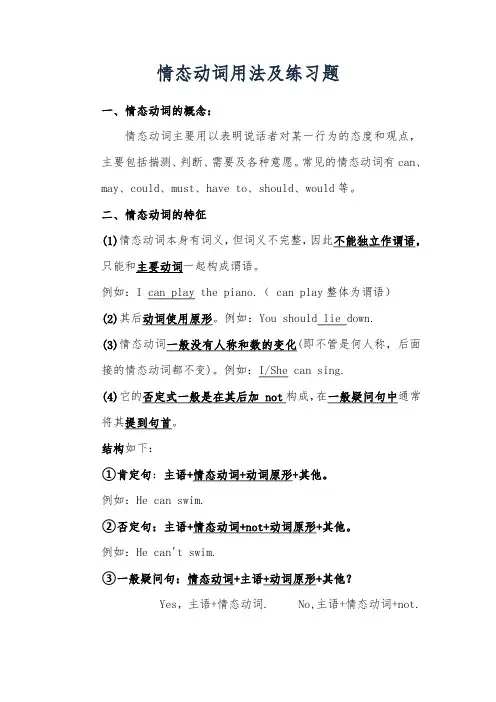
情态动词用法及练习题一、情态动词的概念:情态动词主要用以表明说话者对某一行为的态度和观点,主要包括揣测、判断、需要及各种意愿。
常见的情态动词有can、may、could、must、have to、should、would等。
二、情态动词的特征(1)情态动词本身有词义,但词义不完整,因此不能独立作谓语,只能和主要动词一起构成谓语。
例如:I can play the piano.( can play整体为谓语)(2)其后动词使用原形。
例如:You should lie down.(3)情态动词一般没有人称和数的变化(即不管是何人称,后面接的情态动词都不变)。
例如:I/She can sing.(4)它的否定式一般是在其后加 not构成,在一般疑问句中通常将其提到句首。
结构如下:①肯定句:主语+情态动词+动词原形+其他。
例如:He can swim.②否定句:主语+情态动词+not+动词原形+其他。
例如:He can't swim.③一般疑问句:情态动词+主语+动词原形+其他?Yes,主语+情态动词. No,主语+情态动词+not.例如:-Can he swim?-Yes, he can. No,he can’t.④特殊疑问句:特殊疑问词+情态动词+主语+动词原形+其他? 例如: -What can he do ?-He can swim.三.情态动词的用法(1)can的用法①表示“能力”Can you sing?你会唱歌吗?②表示客观条件允许You can listen to music here.你可以在这里听音乐。
You can’t park your car here. 你不能在此停车③can用在否定句和疑问句中时,有时表示说话人的怀疑、惊异、或猜测:It can’t be true.这不可能是事实Can it be true?这可能是真的吗?④.can的搭配用法:A.as +adj./adv.+as one can/could “尽可能,尽量……”,如:The man took his child to the hospital as quickly as he could.这个男人尽可能快地将孩子送去医院。
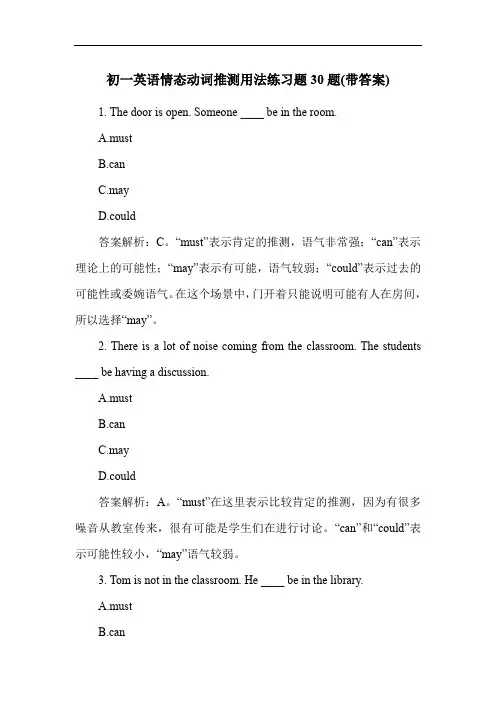
初一英语情态动词推测用法练习题30题(带答案)1. The door is open. Someone ____ be in the room.A.mustB.canC.mayD.could答案解析:C。
“must”表示肯定的推测,语气非常强;“can”表示理论上的可能性;“may”表示有可能,语气较弱;“could”表示过去的可能性或委婉语气。
在这个场景中,门开着只能说明可能有人在房间,所以选择“may”。
2. There is a lot of noise coming from the classroom. The students ____ be having a discussion.A.mustB.canC.mayD.could答案解析:A。
“must”在这里表示比较肯定的推测,因为有很多噪音从教室传来,很有可能是学生们在进行讨论。
“can”和“could”表示可能性较小,“may”语气较弱。
3. Tom is not in the classroom. He ____ be in the library.A.mustB.canD.could答案解析:C。
“may”表示有可能,因为汤姆不在教室,只是有可能在图书馆,不能确定,所以选择“may”。
“must”语气太强,“can”和“could”也不太符合这个场景。
4. The light in the office is on. Someone ____ be working there.A.mustB.canC.mayD.could答案解析:C。
灯亮着只能说明有可能有人在办公室工作,“may”语气较弱,符合这个场景。
“must”太肯定,“can”和“could”也不太恰当。
5. There are some footprints on the ground. Someone ____ have walked here.A.mustB.canC.mayD.could答案解析:C。
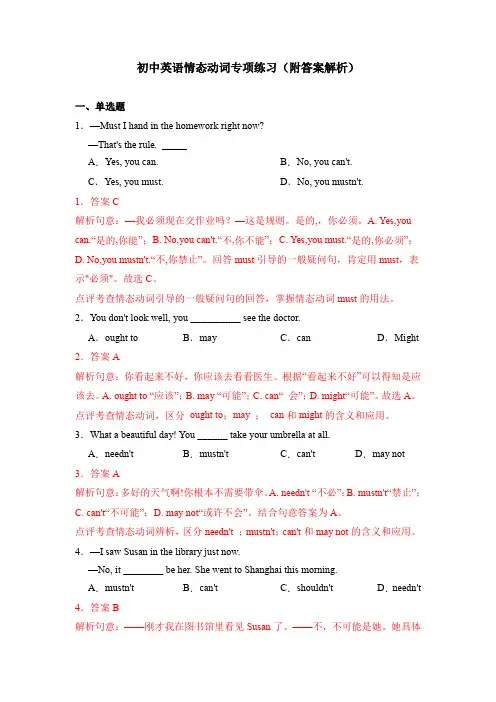
初中英语情态动词专项练习(附答案解析)一、单选题1.—Must I hand in the homework right now?—That's the rule.A.Yes, you can.B.No, you can't.C.Yes, you must.D.No, you mustn't.1.答案C解析句意:—我必须现在交作业吗?—这是规则。
是的,,你必须。
A. Yes,you can.“是的,你能”;B. No,you can't.“不,你不能”;C. Yes,you must.“是的,你必须”;D. No,you mustn't.“不,你禁止”。
回答must引导的一般疑问句,肯定用must,表示"必须"。
故选C。
点评考查情态动词引导的一般疑问句的回答,掌握情态动词must的用法。
2.You don't look well, you __________ see the doctor.A.ought to B.may C.can D.Might 2.答案A解析句意:你看起来不好,你应该去看看医生。
根据“看起来不好”可以得知是应该去。
A. ought to “应该”;B. may “可能”;C. can“ 会”;D. might“可能”。
故选A。
点评考查情态动词,区分ought to;may ;can和might的含义和应用。
3.What a beautiful day! You ______ take your umbrella at all.A.needn't B.mustn't C.can't D.may not 3.答案A解析句意:多好的天气啊!你根本不需要带伞。
A. needn't “不必”;B. mustn't“禁止”;C. can't“不可能”;D. may not“或许不会”。
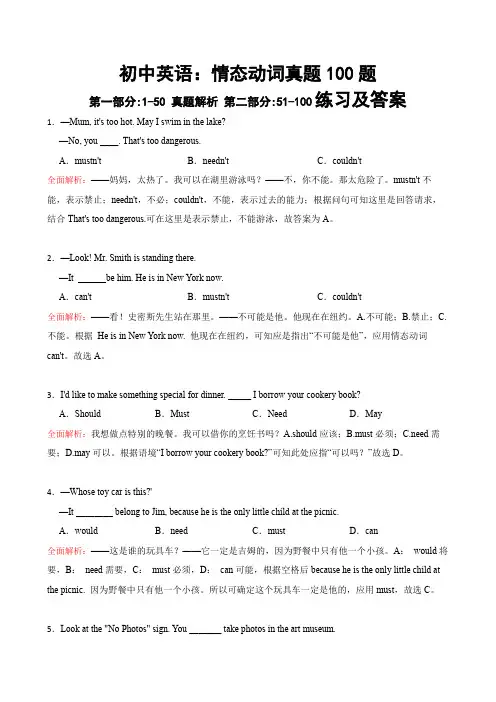
初中英语:情态动词真题100题第一部分:1-50 真题解析第二部分:51-100练习及答案1.—Mum, it's too hot. May I swim in the lake?—No, you ____. That's too dangerous.A.mustn't B.needn't C.couldn't全面解析:——妈妈,太热了。
我可以在湖里游泳吗?——不,你不能。
那太危险了。
mustn't不能,表示禁止;needn't,不必;couldn't,不能,表示过去的能力;根据问句可知这里是回答请求,结合That's too dangerous.可在这里是表示禁止,不能游泳,故答案为A。
2.—Look! Mr. Smith is standing there.—It be him. He is in New York now.A.can't B.mustn't C.couldn't全面解析:——看!史密斯先生站在那里。
——不可能是他。
他现在在纽约。
A.不可能;B.禁止;C.不能。
根据He is in New York now. 他现在在纽约,可知应是指出“不可能是他”,应用情态动词can't。
故选A。
3.I'd like to make something special for dinner. _____ I borrow your cookery book?A.Should B.Must C.Need D.May全面解析:我想做点特别的晚餐。
我可以借你的烹饪书吗?A.should应该;B.must必须;C.need需要;D.may可以。
根据语境“I borrow your cookery book?”可知此处应指“可以吗?”故选D。
4.—Whose toy car is this?'—It ________ belong to Jim, because he is the only little child at the picnic.A.would B.need C.must D.can全面解析:——这是谁的玩具车?——它一定是吉姆的,因为野餐中只有他一个小孩。
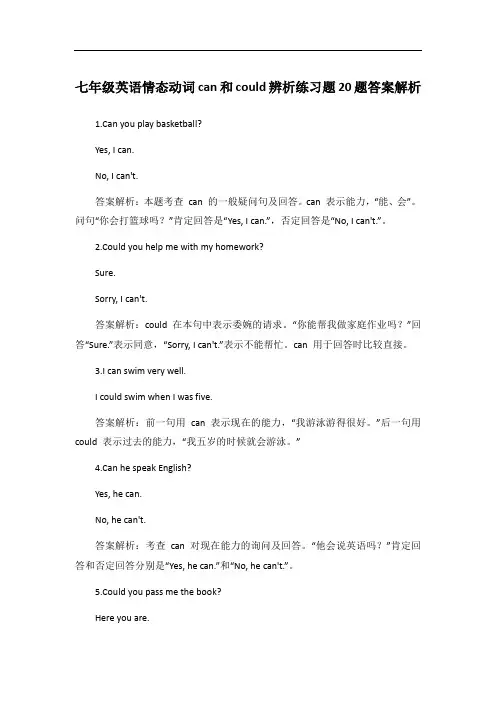
七年级英语情态动词can和could辨析练习题20题答案解析1.Can you play basketball?Yes, I can.No, I can't.答案解析:本题考查can 的一般疑问句及回答。
can 表示能力,“能、会”。
问句“你会打篮球吗?”肯定回答是“Yes, I can.”,否定回答是“No, I can't.”。
2.Could you help me with my homework?Sure.Sorry, I can't.答案解析:could 在本句中表示委婉的请求。
“你能帮我做家庭作业吗?”回答“Sure.”表示同意,“Sorry, I can't.”表示不能帮忙。
can 用于回答时比较直接。
3.I can swim very well.I could swim when I was five.答案解析:前一句用can 表示现在的能力,“我游泳游得很好。
”后一句用could 表示过去的能力,“我五岁的时候就会游泳。
”4.Can he speak English?Yes, he can.No, he can't.答案解析:考查can 对现在能力的询问及回答。
“他会说英语吗?”肯定回答和否定回答分别是“Yes, he can.”和“No, he can't.”。
5.Could you pass me the book?Here you are.Sorry, I can't find it.答案解析:could 表示委婉的请求,“你能把书递给我吗?”回答“Here you are.”表示递给对方书,“Sorry, I can't find it.”表示找不到书不能递给对方。
6.I can draw pictures.I could draw pictures yesterday.答案解析:第一句用can 表示现在的能力,“我会画画。
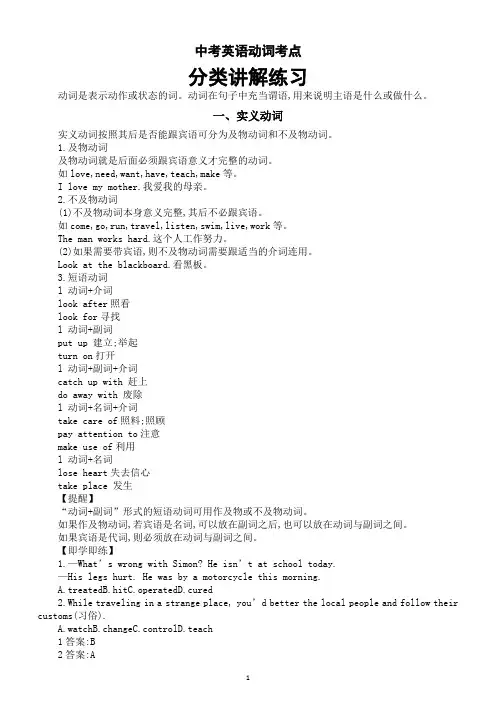
中考英语动词考点分类讲解练习动词是表示动作或状态的词。
动词在句子中充当谓语,用来说明主语是什么或做什么。
一、实义动词实义动词按照其后是否能跟宾语可分为及物动词和不及物动词。
1.及物动词及物动词就是后面必须跟宾语意义才完整的动词。
如love,need,want,have,teach,make等。
I love my mother.我爱我的母亲。
2.不及物动词(1)不及物动词本身意义完整,其后不必跟宾语。
如come,go,run,travel,listen,swim,live,work等。
The man works hard.这个人工作努力。
(2)如果需要带宾语,则不及物动词需要跟适当的介词连用。
Look at the blackboard.看黑板。
3.短语动词l 动词+介词look after照看look for寻找l 动词+副词put up 建立;举起turn on打开l 动词+副词+介词catch up with 赶上do away with 废除l 动词+名词+介词take care of照料;照顾pay attention to注意make use of利用l 动词+名词lose heart失去信心take place 发生【提醒】“动词+副词”形式的短语动词可用作及物或不及物动词。
如果作及物动词,若宾语是名词,可以放在副词之后,也可以放在动词与副词之间。
如果宾语是代词,则必须放在动词与副词之间。
【即学即练】1.—What’s wrong with Simon? He isn’t at school today.—His legs hurt. He was by a motorcycle this morning.A.treatedB.hitC.operatedD.cured2.While traveling in a strange place, you’d better the local people and follow their customs(习俗).A.watchB.changeC.controlD.teach1答案:B2答案:A二、系动词系动词不能单独作谓语,必须与表语一起构成谓语。
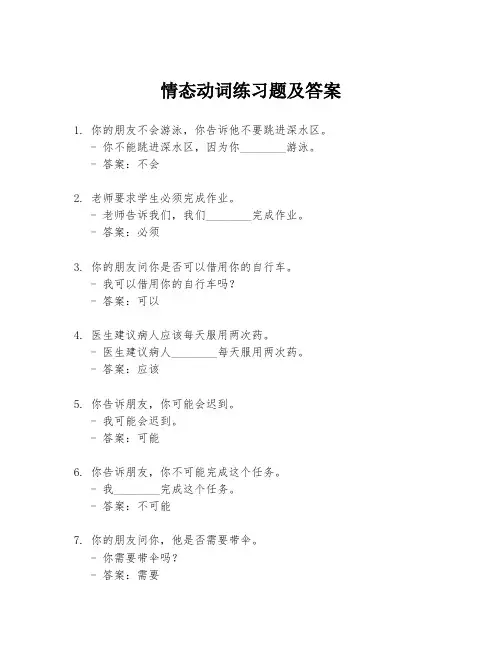
情态动词练习题及答案1. 你的朋友不会游泳,你告诉他不要跳进深水区。
- 你不能跳进深水区,因为你________游泳。
- 答案:不会2. 老师要求学生必须完成作业。
- 老师告诉我们,我们________完成作业。
- 答案:必须3. 你的朋友问你是否可以借用你的自行车。
- 我可以借用你的自行车吗?- 答案:可以4. 医生建议病人应该每天服用两次药。
- 医生建议病人________每天服用两次药。
- 答案:应该5. 你告诉朋友,你可能会迟到。
- 我可能会迟到。
- 答案:可能6. 你告诉朋友,你不可能完成这个任务。
- 我________完成这个任务。
- 答案:不可能7. 你的朋友问你,他是否需要带伞。
- 你需要带伞吗?- 答案:需要8. 你告诉朋友,你或许会参加晚会。
- 我或许会参加晚会。
- 答案:或许9. 你的朋友问你,他是否应该接受这个工作。
- 你应该接受这个工作吗?- 答案:应该10. 你告诉朋友,你不得不去开会。
- 我________去开会。
- 答案:不得不11. 你的朋友问你,他是否可以明天再交报告。
- 我可以明天再交报告吗?- 答案:可以12. 你告诉朋友,你可能会去度假。
- 我可能会去度假。
- 答案:可能13. 你的朋友问你,他是否应该学习英语。
- 你应该学习英语吗?- 答案:应该14. 你告诉朋友,你不可能在一天内完成这个项目。
- 我________在一天内完成这个项目。
- 答案:不可能15. 你的朋友问你,他是否需要帮忙。
- 你需要帮忙吗?- 答案:需要答案1. 不会2. 必须3. 可以4. 应该5. 可能6. 不可能7. 需要8. 或许9. 应该10. 不得不11. 可以12. 可能13. 应该14. 不可能15. 需要通过这些练习题,学习者可以更好地理解和使用情态动词。
情态动词的使用在英语中非常广泛,掌握它们对于提高英语水平至关重要。
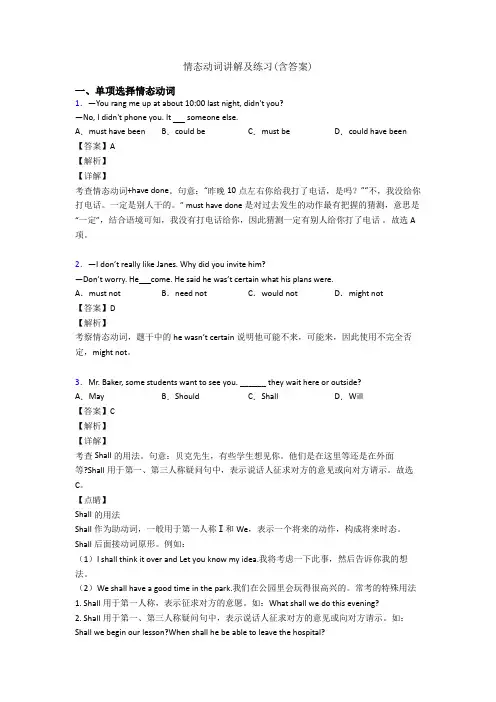
情态动词讲解及练习(含答案)一、单项选择情态动词1.—You rang me up at about 10:00 last night, didn't you?—No, I didn't phone you. It someone else.A.must have been B.could be C.must be D.could have been 【答案】A【解析】【详解】考查情态动词+have done。
句意:“昨晚10点左右你给我打了电话,是吗?”“不,我没给你打电话。
一定是别人干的。
” must have done 是对过去发生的动作最有把握的猜测,意思是“一定”,结合语境可知,我没有打电话给你,因此猜测一定有别人给你打了电话。
故选A 项。
2.—I don’t really like Janes. Why did you invite him?—Don’t worry. He come. He said he was’t certain what his plans were.A.must not B.need not C.would not D.might not【答案】D【解析】考察情态动词,题干中的he wasn’t certain说明他可能不来,可能来,因此使用不完全否定,might not。
3.Mr. Baker, some students want to see you. ______ they wait here or outside?A.May B.Should C.Shall D.Will【答案】C【解析】【详解】考查Shall的用法。
句意:贝克先生,有些学生想见你。
他们是在这里等还是在外面等?Shall用于第一、第三人称疑问句中,表示说话人征求对方的意见或向对方请示。
故选C。
【点睛】Shall的用法Shall作为助动词,一般用于第一人称Ⅰ和We,表示一个将来的动作,构成将来时态。
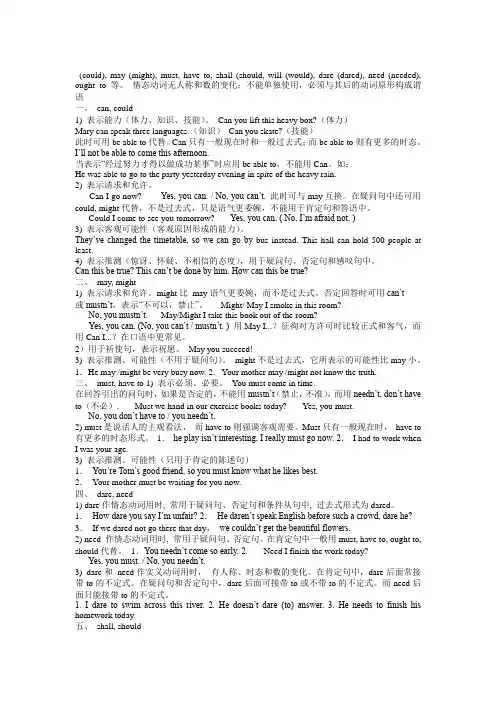
(could), may (might), must, have to, shall (should, will (would), dare (dared), need (needed), ought to等。
情态动词无人称和数的变化;不能单独使用,必须与其后的动词原形构成谓语一、can, could1) 表示能力(体力、知识、技能)。
Can you lift this heavy box?(体力)Mary can speak three languages.(知识)Can you skate?(技能)此时可用be able to代替。
Can只有一般现在时和一般过去式;而be able to则有更多的时态。
I’ll not be able to come this afternoon.当表示“经过努力才得以做成功某事”时应用be able to,不能用Can。
如:He was able to go to the party yesterday evening in spite of the heavy rain.2) 表示请求和允许。
-----Can I go now? ----- Yes, you can. / No, you can’t. 此时可与may互换。
在疑问句中还可用could, might代替,不是过去式,只是语气更委婉,不能用于肯定句和答语中。
---- Could I come to see you tomorrow? ---- Yes, you can. ( No, I’m afraid not. )3) 表示客观可能性(客观原因形成的能力)。
They’ve changed the timetable, so we can go by bus instead. This hall can hold 500 people at least.4) 表示推测(惊讶、怀疑、不相信的态度),用于疑问句、否定句和感叹句中。
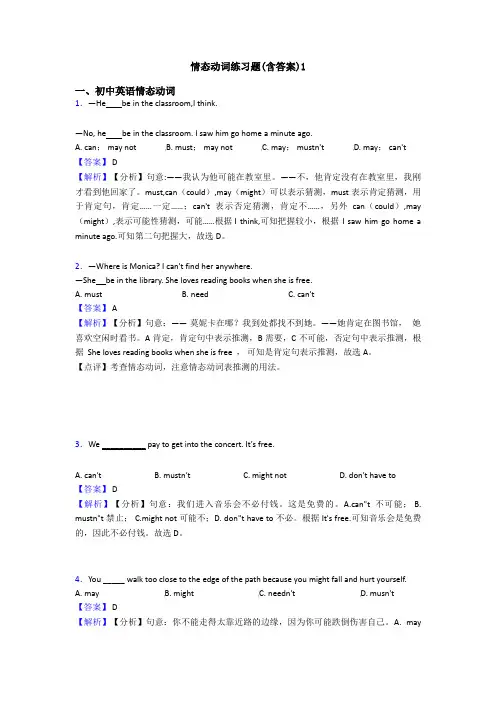
情态动词练习题(含答案)1一、初中英语情态动词1.—He be in the classroom,I think.—No, he be in the classroom. I saw him go home a minute ago.A. can; may notB. must; may notC. may; mustn'tD. may; can't【答案】 D【解析】【分析】句意:——我认为他可能在教室里。
——不,他肯定没有在教室里,我刚才看到他回家了。
must,can(could),may(might)可以表示猜测,must表示肯定猜测,用于肯定句,肯定……一定……;can't表示否定猜测,肯定不……,另外can(could),may (might),表示可能性猜测,可能……根据I think,可知把握较小,根据I saw him go home a minute ago.可知第二句把握大,故选D。
2.—Where is Monica? I can't find her anywhere.—She be in the library. She loves reading books when she is free.A. mustB. needC. can't【答案】 A【解析】【分析】句意:——莫妮卡在哪?我到处都找不到她。
——她肯定在图书馆,她喜欢空闲时看书。
A肯定,肯定句中表示推测,B需要,C不可能,否定句中表示推测,根据 She loves reading books when she is free ,可知是肯定句表示推测,故选A。
【点评】考查情态动词,注意情态动词表推测的用法。
3.We __________ pay to get into the concert. It's free.A. can'tB. mustn'tC. might notD. don't have to【答案】 D【解析】【分析】句意:我们进入音乐会不必付钱。
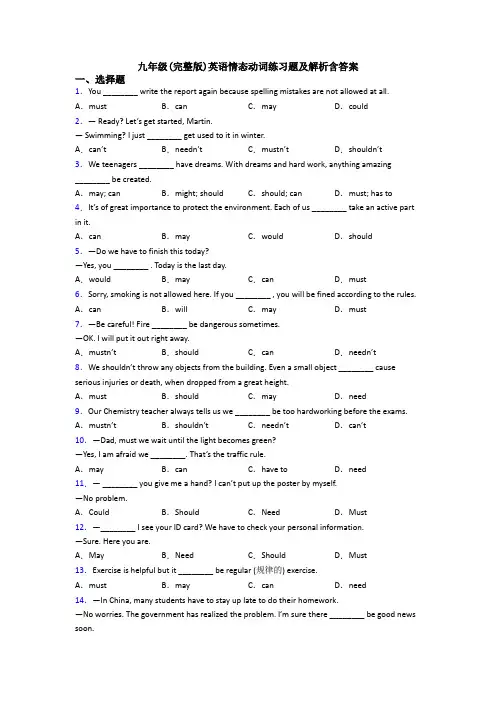
九年级(完整版)英语情态动词练习题及解析含答案一、选择题1.You ________ write the report again because spelling mistakes are not allowed at all. A.must B.can C.may D.could 2.—Ready? Let’s get started, Martin.— Swimming? I just ________ get used to it in winter.A.can’t B.needn’t C.mustn’t D.shouldn’t3.We teenagers ________ have dreams. With dreams and hard work, anything amazing________ be created.A.may; can B.might; should C.should; can D.must; has to 4.It’s of great importance to protect the environment. Each of us ________ ta ke an active part in it.A.can B.may C.would D.should5.—Do we have to finish this today?—Yes, you ________ . Today is the last day.A.would B.may C.can D.must 6.Sorry, smoking is not allowed here. If you ________ , you will be fined according to the rules. A.can B.will C.may D.must7.—Be careful! Fire ________ be dangerous sometimes.—OK. I will put it out right away.A.mustn’t B.should C.can D.needn’t8.We shouldn’t throw any objects from the building. Even a small object ________ cause serious injuries or death, when dropped from a great height.A.must B.should C.may D.need9.Our Chemistry teacher always tells us we ________ be too hardworking before the exams. A.mustn’t B.shouldn’t C.needn’t D.can’t 10.—Dad, must we wait until the light becomes green?—Yes, I am afraid we ________. That’s the traffic rule.A.may B.can C.have to D.need11.—________ you give me a hand? I can’t put up the poster by myself.—No problem.A.Could B.Should C.Need D.Must12.—________ I see your ID card? We have to check your personal information.—Sure. Here you are.A.May B.Need C.Should D.Must 13.Exercise is helpful but it ________ be regular (规律的) exercise.A.must B.may C.can D.need14.—In China, many students have to stay up late to do their homework.—No worries. The gov ernment has realized the problem. I’m sure there ________ be good news soon.A.can B.should C.must D.need 15.—Where is Tom? I am considering ________ him about the result of the exam.—Oh. You ________. He has known it already.A.to tell; can't B.telling; needn't C.tell; mustn't D.told; shouldn't 16.I ________ hear you clearly. Would you please repeat it?A.mustn’t B.can’t C.needn’t D.shouldn’t 17.— Mom, must I clean my room now?— No, you ________. You can do it after dinner.A.needn’t B.mustn’t C.shouldn’t D.can’t18.It’s amazing that the pen ________turn voice into text with few mistakes.A.can B.must C.may D.need 19.Please don't make so much noise. I ________ hear the speaker very well.A.needn't B.can't C.shouldn't D.mustn't20.The boy is very brave.I ________ he ________ the tall tree.A.dare say; dares to climbB.dare to say; dare climbingC.dare saying; dares climbD.dare to say; dares climbed21.—The high school entrance examination is coming!—Yes, our teacher tells us we _______ be too careful while taking exams.A.mustn't B.shouldn't C.needn't D.can't22.We’ve discussed every detail of this plan and have got everything ready. But still something __________ go wrong. We still have to be very careful.A.must B.should C.would D.may 23.—Amy, I hear you've got many foreign coins._______ I have a look?—Of course, I'll fetch them for you.A.May B.MustC.Should D.Need24.When I was young, my father ___________ take me to climb the hill which was not far from our house.A.may B.must C.would D.should25.— Is Lang Lang going to perform at Art Center this Friday?— Yes. It ________ be him. He has been here for three days.A.might B.must C.mustn’t D.may26.—Will Jim come to Yangzhou for a holiday?—He ________come and it depends on how much homework he will have.A.may B.should C.must D.need 27.—Could I join you in the programme?—Sorry, you ________. You are too young.A.shouldn’t B.mustn’t C.can’t D.needn’t 28.—Who is singing next door? It sounds like a young girl’s voice.—It _________ be Jane. But she seldom sings English songs.A.need B.must C.may D.can29.Hurry up, or we ________ miss the beginning of the film.A.should B.must C.may D.have to30.You ________ require others to do with the problem like you. Everyone has his own way. A.mustn’t B.needn’t C.may not D.shouldn’t 31.— Excuse me, could you tell me where the Nanjing Brocade Museum is?—Go along this road for five minutes. You ________ miss it. It’s a huge building.A.mustn’t B.can’t C.needn’t D.shouldn’t 32.—Must the children leave at six tomorrow morning?—No, they _______. They can have more time to get ready for the trip.A.can’t B.needn’t C.mustn’t D.may not33.A hard-working man ________ become a great scientist, but a great scientist ________ be a hard-working man.A.can’t; can B.may not; must C.can’t; must D.may not; can 34.—What is that young lady’s job?—She ________ be a nurse, I’m not sure.A.must B.may C.need D.would35.— Listen! Tom ________ be listening to the music while doing his homework.—Let’s go upstairs to remind him to turn it off.A.should B.could C.would D.must 36.—Must I finish all my homework today, Mum?—No, you ________, my dear. You can finish some tomorrow if you like.A.needn’t B.shouldn’t C.can’t D.mustn’t37.You ________ drive after drinking alcohol(酒). It’s against the law.A.mustn’t B.needn’t C.couldn’t D.wouldn’t 38.Never throw objects from the building. Even a small object ________ cause serious injuries, or death, when dropped from a great height.A.must B.should C.may D.need39.—Is it really necessary for me to go shopping with a mask on?—I’m afraid you ________ in public. It is not only to protect yourself but also to protect others. A.must B.should C.can D.need40.I think all the students love the weekends because, to them, they ________ get up early on Saturdays or Sundays.A.mustn’t B.don’t need C.needn’t D.can’t41.— Is the boy over there Tom? He often wears a jacket like that.— It _______ be him. He is absent from school today.A.needn’t B.shouldn’t C.mustn’t D.can’t42.You ________ pay too much attention to protecting yourself if you plan to go abroad. A.mustn’t B.can’t C.shouldn’t D.needn’t 43.When people are waiting at the zebra crossing, cars and buses ________ wait and let them go first.A.must B.may C.can D.need 44.—Shall I tell him the change of the time right now?—I’m afraid you ________, otherwise he will be late for the meeting.A.can B.may C.must D.need 45.—Will dad arrive home at 6 o’clock to have dinner with us this evening?— I think he will, but he ________ not. Sometimes he works extra hours.A.can B.must C.need D.may 46.Sometimes smiles ________ be false, hiding other feelings like anger, fear or worry. A.should B.would C.must D.can47.— The sandstorm in Beijing is so serious this year.— Yes, I wonder when we ________ worry about the air we breathe.A.can’t B.mustn’t C.needn’t D.shouldn’t 48.—How beautiful the winter jasmines (迎春花) are!—Yes. These golden-yellow flowers ________ be widely seen in my city in March.A.must B.can C.would D.should 49.—Mum, I bought some strawberries on my way home.—Oh, you’re so sweet. But the strawberries ________ be put into the fridge for freshness. A.must B.can C.may D.need 50.—Suzy described every detail of the accident just now.—Her memory ________ be completely back.A.shall B.need C.must D.could【参考答案】***试卷处理标记,请不要删除一、选择题1.A解析:A【详解】句意:你必须重新写报告,因为根本不允许有拼写错误。
初中英语:情态动词真题100题第一部分:1-50 真题解析第二部分:51-100练习及答案1.—Mommy, may I go swimming now?—Yes, honey, but remember that you _____go with your Daddy.A.must B.may C.would D.can全面解析:——妈妈,我现在可以去游泳了吗?——是的,亲爱的,但记住你必须和你爸爸一起去。
must必须;may可以,可能;would将会;can能;根据yes和转折词but,可知是可以去但必须跟爸爸一起,must符合题意,故答案为A。
2.— Whose notebook is this?— It _______________ Bill's. It has his name on it.A.can't be B.must be C.can be D.mustn't be全面解析:——这是谁的笔记本?——一定是比尔的。
can't be不可能是,表示否定的推测;must be 一定是;can be可以是,可能;上面有他的名字。
mustn't be 不能;根据It has his name on it. 上面有他的名字,可知,这个笔记本一定是吉姆的,表示肯定的推测,故答案为B。
3.—____________ you call back tomorrow?— Of course I can.A.Can B.Must C.May D.Need全面解析:——你能明天再打来吗?——我当然可以。
can,可以;must,必须;may,可以,主语常用第一人称;need,必须。
都是情态动词。
从答语中can知,问句也用can。
故选A。
4.— Two hundred yuan for such a T-shirt! You ___________________ be joking!— I'm not joking. It's made of silk.A.can't B.can C.need D.must全面解析:——这样一件T恤要两百块!你一定是在开玩笑!——我不是在开玩笑。
情态动词专项讲解及练习一、初中英语情态动词1.—Mum,Iplayfootballthisafternoon?—Sure,butyou_finishyourhomeworkfirst.A.may;couldB.can;mustC.can;mustn'tD.may;can't【答案】B【解析】【分析】句意:-妈妈,今天下午我能踢足球吗?-当然,但是你必须先完成作业。
前句提请求,can,may都可以;后句,由sure可知后句用肯定回答。
Could表示一种委婉的语气;must表示主观愿望:必须。
妈妈要求孩子“必须"先完成作业。
故选B。
【点评】考查情态动词辨析,may表示请求时候的回答用语。
2.Accordingtothelaw,traffickeeptotheleftinEngland.A.mayB.mustC.needD.can【答案】B【解析】【分析】句意:根据法律规定,在英国车辆必须靠左形式。
A.may可以,表示允许;B.must必须,表示要求;C.need需要,表示必要性;D.can能,表示能力。
根据Accordingtothelaw,可知法律的要求,应是必须的,应用must,故答案为B。
【点评】考查情态动词。
掌握情态动词的常用法。
3.__________ —IwearatietoJanet'sbirthdayparty?—No,youneedn't.Butdoremembertobringherapresent.A.MustB.ShouldC.NeedD.Can【答案】A【解析】【分析】句意:——我必须戴领带去参加Jane的生日聚会吗?——不,你不必,但是记住给她带个礼物。
对于must的否定回答是用needn't。
而should应该;need需要;can可以。
所以根据回答可知选A。
【点评】考查情态动词的基本用法。
4.—Shallwemeetatthestationat9a.m.?—Infactwe.Thetrainuntil11a.m.A.needn't;willleaveB.needn't;won'tleaveC.mustn't;leavesD.mustn't;doesn'tleave【答案】B【解析】【分析】句意:—我们上午9点在车站见面好吗?—事实上我们不需要。
情态动词专项练习题及答案一、初中英语情态动词1.— I take the magazine out of the reading room?— I'm sorry you .A. Could; couldn'tB. Must; couldn'tC. Will; can'tD. May; can't【答案】 D【解析】【分析】句意:——我可以把杂志带出阅览室吗?——对不起,你不能。
could 能,可以;must必须;will将;may可以;can能,可以,can't不可以,不能。
此处表示请求许可,用could或者may,由could或者may构成的一般疑问句,肯定回答用yes,主语+can,否定回答用sorry,主语+can't,结合选项,故答案选D。
【点评】考查情态动词的辨析。
注意理解句意,理解选项,根据语境,选出正确的答案。
2.— Shall I book some seats for the concert?—______. I've done that.A. Yes, you mayB. No, you mustn'tC. No, you needn'tD. No, you can't【答案】C【解析】【分析】Yes, you may是的,你可以;No, you mustn't 不,你千万不要;No, you needn't不,你不必;No, you can't不,你不能。
句意:我要预定一些音乐会的座位吗?根据下文,我已经办了。
可知选C最符合语境。
【点评】考查交际用语3.— _________ I take my cousin Shirley with us, Mr. Wu?— Yes, but we'll get there by bike. ____________ she ride a bike?— Yes, and she ___________ ride a bike when she was only six years old.A. Could; can; couldB. Can; can; canC. Can; could; couldD. Could; could; can【答案】 A【解析】【分析】句意:-我能带我表弟雪莉和我们一起吗,吴先生?-是的,但我们将骑自行车去那儿。
初中英语情态动词详细用法归纳(含练习及答案)情态动词有具体的词义, 但也同助动词一样, 需要与其他词语一起构成句子的谓语, 另外情态动词没有人称和数的变化, 情态动词后必须跟动词原形。
1.ca.的用法:(1).表示能力、许可、可能性.表示能力时一般译为“能、会”.即有种能力, 尤其是生来具备的能力.如:Sh.ca.swi.fast.bu..can’.. 她能游得很快, 但我不能。
.ca.se.wit.m.eyes.我用眼睛看。
could是can的过去式。
表示过去的能力.b.abl.t.d.sth.常常指经过努力,花费了时间和劳力之后才能做到某事。
is/am/ar.abl.t.d.sthwas/were able to do sth.(2).表示许可, 常在口语中。
如: .m.dictionary..你可以用我的字典。
(3).表示推测, 可能性, 意为“可能”.常用于否定句和疑问句中.此时can’.译为.不可能”.如:Ca.th.new.b.true.这个消息会是真的吗?—Ca.i.b.ou.teacher?那个人有可能是我们老师吗?—No.i.can’.b.ou.teacher.H.i.o..visi.t.th.Grea.Wall.不可能。
咱们老师正在游览长城呢。
【例题】—.thin.Mis.Ga.mus.b.i.th.library.Sh.sai.sh.woul.g.there.—No.Sh.__b.there..hav.jus.bee.there..A.can’.B.mustn’.C.needn’.D.wouldn’t【解析】根据下文“我刚去过那儿”可知, 应为“不可能”, can’t 表示推测[答案] Acould的用法:(1).can的过去式, 意为.能.会”, 表示过去的能力。
如: H.coul.writ.poem.whe.h.wa.10. 他十岁时就会写诗。
(2).could在疑问句中, 表示委婉的语气, 此.coul.没有过去式的意思。
情态动词的用法及专项练习第1 & 2类:第3类:1.could have p.p.①指过去某事有可能发生, 但并未.真的..发生。
They could have won the race, but they didn't try hard enough.He could have studied harder, but he was too lazy and that's why he failed the exam.②指过去有能力做某事, 但并未真的...做过。
I could have stayed up late, but I decided to go to bed early.Julie could have bought the book, but she borrowed it from the library instead.③对过去的发生事情做出一种猜测,但实际上并不知道真假。
仅仅是做一种观点上的表达。
He could have got stuck in traffic.He could have forgotten that we were meeting today.He could have overslept.2. may / might have p.p.(用法与could have p.p.第③点相同)对过去的发生事情做出一种猜测,但实际上并不知道真假。
仅仅是做一种观点上的表达。
He might have got stuck in traffic.He might have forgotten that we were meeting today.He might have overslept.3. couldn't have p.p.渴望、期望做某事, 但由于外部原因不可能做成, 即便是很想做。
是一种虚拟语气。
I couldn't have arrived any earlier. There was a terrible traffic jam (= it was impossible for me to have arrivedany earlier).He couldn't have passed the exam, even if he had studied harder. It's a really, really difficult exam.4. should / ought to have p.p.有一个好主意,该做而没有做。
初中英语情态动词练习题及含答案情态动词练习(1)1. May I stop my car here? No, you____.A. can'tB. mustn'tC. needn'tD. don't have to2. Must we clean the house now? No, you _______.A. needn'tB. may notC. mustn'tD. can't3. John his father about his failure in the exam.A. dares not tellB. dares not tellingC. dare not tellD. dares not to tell4. You return the book now. You can keep it next week if you like.A. can'tB. mustn'tC. needn'tD. may not5. Johnny, you play with the knife, you hurt yourself.A. won't...can'tB. mustn't...mayC. shouldn't, mustD. can't...shouldn't6. The fire spread through the hotel very quickly but everyone get out.A. had toB. wouldC. couldD. was able to7. Would you go out for a walk with me?No, I . My girl friend is coming.A. wouldn'tB. shall notC. won'tD. shouldn't8. Man die without water. A. will B. can C. need D. shall9. If he started at 9 0'clock, he be there by now.A. needB. shallC. ought toD. must10. I mailed the letter two weeks ago. She_____it.A. must receiveB. can't receiveC. might receiveD. must have received11.The professor gave orders that the experiment before 5:30p.m.A. be finishedB. will finishC. must be finishedD. would be finished12. There was plenty of time. You_____.A. mustn't hurryB. mustn't have hurriedC. needn't hurryD. needn't have hurried13. Tom was a diligent boy. He go to school though it was raining hard.was able to B. could C. couldn't D. wasn't able to14. ______I go back before lunch? No, I don't think you________.A. Need...mustB. Do...need toC. Must...have toD. May .... ought to15. The teacher do all the exercises, but a pupil_______.A. needn't....mustB. may not...mustC. needn't....needn'tD. can't....must16. Would you open the window please ? Yes, I______.A. willB. wouldC. doD. can17. A lion only attacks a human being when it is hungry.A. shouldB. canC. willD. shall18. ____Must I finish this novel this morning ?____No, you_____.A. mustn'tB. might notC. don't have toD. can't19. The taxi ____ only hold six passengers. It is full. You take the next one.A. may...mayB. can...mayC. may...canD. must...can20. I a little earlier, but I met a friend of mine on the way.A. may comeB. may have comeC. could have comeD. must have come21. I wish to go home now, I?A. mayB. can'tC. mustD. do22. He must have finished his homework, he?A. mustn'tB. didn'tC. needn'tD. hasn't23. This pen looks like mine, yet it isn't. Whose it be?A. mustB. canC. mayD. might24. He didn't do well in the exam. He hard at his lessons.A. must have workedB. ought to have workedC. would have workedD. has worked25. I wonder how he that to the teacher.A. dare to sayB. dare sayingC. not dare sayD. dared say26. Mr Baker, a number of students want to see you. _____ they wait here or outside?A. ShouldB. WillC. ShallD. Are27. You the trees. Look, it is raining now.A. mustn't have wateredB. needn't have wateredC. could have wateredD. might have watered28. I give you an answer tomorrow. I promise!A. mustB. willC. mayD. shall29. As a soldier, you do as the head tells you.A. willB. shallC. mayD. ought30. The streets are all dry. It_____ during the night.A. can't have rainedB. must have rainedC. couldn't rainD. shouldn't have rained31. "When _____ he leave the hospital?" I asked the doctor.A. willB. shallC. canD. may32. They have not finish the work up to now.____Well, they ______A. should haveB. shouldC. ought toD. ought have33. Since it is already midnight, we______.A. had better leavingB. ought to have leaveC. should take our leaveD. might as well leave34. you be happy!A. MayB. CanC. MustD. Would35. Must we come tomorrow?A. No, you can'tB. No, you needn'tC. No, you mustn'tD. No, you may not36. You miss the lesson, though we have it on Thursday.A. mustn't...needn'tB. needn't....mustn'tC. mustn't...mustn'tD. needn't...needn't37. To succeed in a difficult task,_____.A. one needs to work hardB. to work hard is neededC. you need be a hard working personD. to work hard is what one needs38. In case I______, I would try again.A. will failB. would missC. should failD. shall miss39. Some people feel that handguns______.A. should controlB. should be controlledC. must be controllingD. can be control40. ______ open the door for you ?A. Would you like that IB. Do you want that IC. Will ID. Shall I41. My son ____ the examination, but he wasn't careful enough.A. might be able to passB. must have passedC. could have passedD. were able to pass42. Isn't it strange that the lazy boy pass the exam?A. shouldB. hasC. mightD. would43. We the work so early without your help.A. couldn't finishB. can't finishC. couldn't have finishedD. can't have finished44. We the manager, but no one _____ his telephone number.A. could have called, knewB. could have called, had knownC. could call, had knownD. could call, knew45. "Would you come and join them?""I wish I . But I am busy at this moment.A. can'tB. couldn'tC. couldD. can46. If Alice this afternoon, the meeting should be put off.A. would not comeB. might not comeC. should not comeD. could not come47. I didn't see her in the meeting room this morning. She at the meeting.A. mustn't have spokenB. shouldn't have spokenC. needn't have spokenD. couldn't have spoken48. With so much work on hand, you to see the game last night.A. mustn't goB. shouldn't goC. couldn't have goneD. shouldn't have gone49. I thought you like something to read, so I have brought you some books.A. mayB. mightC. couldD. must50. There was plenty of time. She______.A. mustn't have hurriedB. couldn't have hurriedC. must not hurryD. needn't have hurried51. It's still early, you______.A. mustn't hurryB. wouldn't hurryC. may not hurryD. don't have to hurry52. Please open the window,________?A. can't youB. aren't youC. do youD. will you53. We for her because she never came.A. mustn't have waitedB. shouldn't have waitedC. mustn't waitD. needn't wait54. May I stop here?No, you ____.A. mustn'tB. might notC. needn'tD. won't55. He _____ you more help, even though he was very busy.A. might have givenB. might giveC. may have givenD. may give56. I didn't see her in the meeting room this morning. She at the meeting.A. mustn't have spokenB. shouldn't have spokenC: needn't have spoken D. couldn't have spoken57. Could I borrow your dictionary? Yes, of course you______.A. mightB. willC. canD. should58. Please don't make a noise. --I'll be as quiet as a mouse.A. Yes, I won'tB. No, I won'tC. No, I willD. Yes, I will59. The young man has made so much noise that he not have been allowed to attend theconcert.A. couldB. mustC. wouldD. should60. One ought for what one has done.A. not to be punishedB. to not be punishedC. to not punishedD. not be punished61. If you really want yourself to be in good health, you must always so much..A. not, be smokingB. not, have smokedC. not, to smokeD. be not, smoking62. Where is Mary?She isn't here. I think she_____.A. may have gone homeB. must have gone homeC. might have gone homeD. All the above63. I think Helen is at home.No, she be at home, for she phoned me from the airport just five minutes ago.A. mustn'tB. needn'tC. can'tD. dared not64. She is already two hours late. What to her?A. can have happenedB. may have happenedC. should have happenedD. must happen65. “ he be watching TV now?”"Yes, he be watching TV now?""No, he be watching TV now."A. Must, can, mustn'tB. Can ,must, can'tC. Can, can, mustn'tD. May, must, needn't66. You must be a writer, ______?A. mustn't youB. are youC. must youD. aren't you67. You must have seen him last night, ?A. haven't youB. didn't youC. don't youD. must you68. I got up early this morning, but I _______so because I had no work to do.A. mustn't have doneB. didn't need to doC. needn't have doneD. can't have done69. Let's say that you could go there again, how feel?A. will youB. should youC. would youD. do you70. I daren't tell you what he did for fear that he angry with.A. will beB. isC. wasD. should be71. Without the leadership of the Party, there no New China.A. would beB. has beenC. wasD. should be72. It is necessary that we a foreign language.A. must masterB. ought to masterC. masterD. should master73. Most of the students felt rather disappointed at the English party. They say that it _______ better organized.A. had beenB. had to beC. must have beenD. could have been74. I am surprised that he to help me when I needed it most.A. should refuseB. would have refusedC. should have refused toD. may have refused75. Look! Tom is too sleepy to work .He __ up watching TV.A. mustn't have stayedB. shouldn't have stayedC. mustn't stayD. ought not to say. 练习题答案1-10 BACCB DCADD 11-20 ADACA ACCBC 21-30 ADBBDCBBBA 31-40 BADAB AACBD 41-50 CACAC CDDBD 51-60 DDBAA DCBDA61-70 ADCAB DBCCB 71-75 ADDCB。
情态动词一、考点、热点回顾【词汇辨析】1.sometimes/ some times/sometime/ some time:sometimes: “有时”=at times. He is sometimes late for school.some times: “几次” I have been to Nanjing some times.sometime: “某一时刻” I bought it sometime last spring.We’ll meet again sometime next week.some time: “一段时间” We have to stay here for some time.2. many/ much/ a few/ a little/ few/ little(1)many修饰可数名词,much修饰不可数名词;都表示许多。
例如:许多书许多牛奶(2)a few和a little都表示"有一点儿",侧重于肯定,相当于"some",但a few修饰可数名词,a little修饰不可数名词,例如:He has a few friends in London.---Would you like some coffee?---Yes, just a little.(3)few和little表示"几乎没有",侧重否定。
few后接可数名词,little后接不可数名词。
例如:He is a strange man. He has few words.Hurry up, there is little time left.【固定搭配】加-ingbe busy doing sth.忙于做……eg: Mother is busy cooking.look forward to + doing sth. 期待做……eg: Tom looks forward to seeing his father again.Thank you for (doing) sth. 为了…感谢你eg: Thank you for your help.愉快地做某事eg: I had great fun playing in the water.=have a good time doing sth eg: I had a good time playing in the water.have problem/trouble/difficulty (in)doing sth.做某事有困难eg: I have difficulty finishing my homework in 2 hours.【情态动词】又叫情态助动词。
它们具有以下特点:⑴它们必须与其他动词连用,即:情态动词+动词原形表示说话人对所述动作的看法,如需要、可能、意愿或怀疑等。
⑵绝大多数情态动词没有人称和数的变化,即第三人称单数不加-s(以be和have 开头的情态动词短语除外)。
⑶在意义上,情态动词具有“多义性”。
例:can既可表示能力,又可表示可能、允许等意义。
【情态动词的基本用法】1. can的基本用法:⑴表示体力或智力上的能力,即“能够,会”,可与be able to转换。
例:He can speak English. = He is able to speak English.—Can you play basketball?— No, I can’t.如果表示将来具备的能力,要用will be able to。
例:If I have a good sleep, I will be able to do the problem.⑵表示许可,主要用于口语,书面语一般用may。
例:—Can we go home now, please?— No, you can’t.You can only smoke in this room.You can’t keep the library books for more than a month.⑶表示“可能”,与may同义,但一般用在疑问句中。
例:What can he possibly want?在否定句中,否定形式can’t表示推测“不大可能”。
例:Anybody can make mistakes.The news can’t be true.与第一、二人称连用时,还可以就可能的解决问题的方式或可能的行为提出建议。
在这里,也可用could使语气婉转。
例:Can / Could we meet again next week? 下周我们可以再见面吗?—What shall we do? 我们怎么办呢?— We can / could try asking Lucy for help. ——我们可以请露茜帮忙试试看。
You can / could help me with the cooking. 你可以帮我做饭。
2. may的基本用法:⑴表示“许可”,用can比较口语化。
例:You may / can come if you wish. 如果你想来,你就来。
You may not pick flowers in this park. 本公园内不许摘花。
(may not表示按规定不许可,如果用mustn’t则表示说话人不许可。
)我可以在这里抽烟吗?—mustn’t表示明确的禁止。
)⑵肯定句中表示推测,“可能”。
例:It may rain tomorrow. 明天可能会下雨。
The news may not be true. 这个消息可能不会是真的。
注意:如果例:Can it be true? 那会是真的吗?Who can he be? 他究竟是谁呢?⑶【注意】:……?—Yes, you —No3. must的基本用法:⑴表示必须,强调说话人的主观意志。
例:I must go now, or I’ll be late.You must be here by ten o’clock.【注意】:表示“必须“时,must,而不是mustn’t。
也就是:—Must I/we do it now?—Yes, you—No, you例:—Must I go with them?—No, you.⑵表示推测,一般只用于肯定陈述句,表示非常肯定。
例:She didn’t look at me. She must be angry. 她不朝我看,一定是生气了。
He is good at English. He must know the word. 他英语好,准知道这个词。
You must be Mr. Jones. 想必您就是琼斯先生吧。
4. have to的基本用法:have to可视为情态动词,但它与其他情态动词在用法上稍有不同。
其他情态动词没有人称和数的变化,而have to却有人称和数的变化,要视主语的不同而变化。
例:I / You / We / They have to….He / She / It has to….You don’t have to….Does she have to…?,意思是“必须,不得不”。
和must不同之处:must强调主观需要have to强调客观需要。
例:Sorry, I have to leave now. 对不起,现在我得走了。
I’ve got to go to a meeting. 我得去参加一个会议。
Will he have to work deep into the night? 他将不得不工作到深夜吗?5. need的基本用法:need的基本词义是“需要”,它既可作情态动词,又可作实义动词。
⑴ need用作情态动词时,只用于否定句和疑问句。
它只有一种形式,后接动词原形。
例:I don’t believe you need worry. 我相信你没有必要焦急。
—Need we go so soon? 我们需要这么早就去吗?— Yes, we must. / No, we needn’t. 是的,必须。
/不,不必。
So I needn’t tell him, need I? 所以我不需要告诉他,对吧?请比较以下两句话的不同意思:You needn’t buy the coat. 你没有必要买那件外衣。
(你还没买)You needn’t have bought the coat. 你没有必要买这件外衣的。
(而你却买了)【注意】:I/we……?—Yes,—No, you⑵need用作实义动词时,有时态、人称和数的变化。
如果人作主语,一般后接带to的动词不定式。
即如果物作主语,一般后用例如:I need to look up this word in the dictionary.My watch needs mending/to be mended. 我的手表需要修理了。
We don’t need to work today. (= We needn’t work today.)Does he need to go right now? (= Need he go right now?)6. had better的基本用法:had bette r常略作’d better。
现代语法认为它是一个助动词,因为它后接不带to的动词不定式。
意思是“最好做某事;还是做某事比较好”。
例:You’d better get some sleep. 你最好睡一会儿。
You’d better not do that again. 你最好别再做那件事。
What had we better do now? 我们现在怎么做才好呢?Hadn’t we better tell her the truth? 我们是否最好不告诉她真相?7. could, should, would, might表示推测:①.must多用于肯定句中表示把握性极大的推测,意思为“一定、肯定”。
如: You have worked hard all day. You must be tired. 你已辛苦工作一整天了,一定累了。
The book must be his. His name is on the cover. 这本书一定是他的,封面上写着他的名字。
【注意】must不表推测时,在肯定句中意思为“必须(强调内在的职责)”,在否定句中意思为“不许、禁止”,以它开头的疑问句否定回答常用needn’t或don’t (doesn’t) have to。
如:We must obey the traffic rules. 我们必须遵守交通规则。